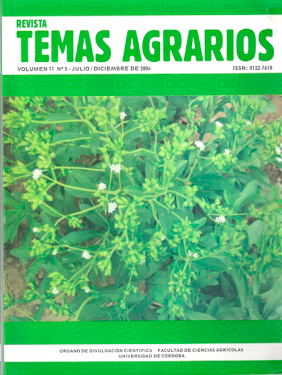Comparison of two field methods for measuring saturated hydraulic conductivity in the mid Sinu valley soils (Córdoba, Colombia).
Comparación de dos métodos de campo para la determinación de la conductividad hidráulica saturada en suelos del Sinú (Córdoba, Colombia).

This work is licensed under a Creative Commons Attribution-NonCommercial 4.0 International License.
Show authors biography
The performance of the tension disc infiltrometer methodology was compared with the ring infiltrometer traditional technique to measure saturated hydraulic conductivity (Ks), in Sinú soils. Two soils were chosen: a clay Endoaquept soil located in the University of Cordoba experimental field and a sandy Haplustepts located in village of Jaraquiel (Montería). Simultaneous infiltration tests were performed in each location until a steady state flow for each was reached followed by calculation of the corresponding Ks values. The Ks values obtained using ring infiltrometer were significantly greater than the ones obtained using disc infiltrometer as a result probably of the differences in depth of the equipment installation and the relative greater area covered by the ring infiltrometer. In clay soil the Ks values obtained with ring infiltrometer were in the range of 1.29 to 6.02 cm h-1, while 0.74 to 2.64 cm h-1 were obtained with disc infiltrometer. In sandy soil Ks values were 4.25 to 24.15 cm h-1 with I A and 2.23 to 7.87 cm h-1 with disc infiltrometer. Cv values in ring infiltrometer were 47% and 52% in clay and sandy soils respectively, whereas with disc infiltrometer method a 37% was obtained for both soils. disc infiltrometer method turns out to be more practical considering the easiness, time, labor, water consumption and costs. Additionally, presents low variability
Article visits 1769 | PDF visits
Downloads
- Ankeny, M.; Ahumed, M.; Kaspar, T. y Horton. R. 1991. Simple field method for determining unsaturated hydraulic conductivity. Soil Science Society American Journal 55:467-470
- Bouwer, H., 1986. Intake rate: Cylinder infiltrometer. En: Klute, A. (Ed.), Methods of Soil Analysis, Part 1. Physical and Mineralogical Methods. American Society of Agronomy, Monograph No 9, Madison, p825-844
- Cook, F. y Broeren, A. 1994. Six methods for determining sorptivity and hydraulic conductivity with disc permeameters. Soil Science 157:2-11
- Dorsey, D.; Ward, A.; Fausey, N. y Bair, E. 1990. A comparison of four field methods for measuring saturated hydraulic conductivity. Transactions of the ASAE 33:1925-1931
- Fuente, C. 1997. Caracterización mínima del suelo con fines de riego. Manual para diseño de zonas de riego pequeñas. Departamento de Irrigación Uach, México, D.F., p1-9
- Gómez, J.; Giráldez, J. y Fereres, E. 2001. Analysis of infiltration and runoff in an olive orchard under no-till. Soil Science Society American Journal 65:291-299
- Gupta, R.; Rudra, R.; Dickinson, N.; Patín, N. y Wall, G. 1993. Comparison of saturated hydraulic conductivity measured by various field methods. Transactions of the ASAE 36:51-55
- Green, W. y Ampt, G. 1911. Studies on soil physics. 1. The flow of air and water through soil. Journal of Agricultural Sciences 4:1-24
- Kostiakov, A. 1932. On the dynamics of the coefficient of water percolation in soils and necessity for studying it from a dynamic view for purposes of amelioration. International Committee Society of Soil Science 61th A:17-21
- Logsdon, S. y Jaynes, D. 1993. Methodology for determining hydraulic conductivity with tension infiltrometers. Soil Science Society American Journal 57:1426-1431
- Merva, G. 1987. The velocity permeameter technique for rapid determination of the hydraulic conductivity in situ. Proceedings of 3rd Workshop on Land Drainage, Ohio State University.
- Moreno, F.; Andreu, L.; Fernández, J. y Cayuela, J. 1993. Medida in situ de las propiedades hidráulicas del suelo. Riegos y Drenajes 21:14-18
- Perroux, K. y White, I. 1988. Designs for disc permeameters. Soil Science Society American Journal 52:1205-1215
- Reynolds, W.; Elrick, D. y Topp, G. 1983. A re-examination of the constant head well permeameter method for measuring saturated hydraulic conductivity above the water table. Soil Science 136 (4):250-268
- Scotter, D.; Clothier, B.; Harper, E. 1982. Measuring saturated hydraulic conductivity and sorptivity using twin rings. Australian Journal of Soil Research 20:295-304
- Smettem, K. y Clothier, B. 1989. Measuring unsaturated sorptivity and hydraulic conductivity using multi-disc permeameters. Journal Soil Science 40:563-568
- Soil Survey Staff. 1981. Soil Survey Handbook 18. USDA, Washington, D.C. 503p USDA. 1999. Natural Resources Conservation Service. Soil Taxonomy. USDA, http:// soils.usda.gov/technical/ classification/taxonomy/ [Accedido: 04-15-2006]
- Torrente, A.; Becerra, C.; Barney, F.; Garcia, A.; Escobar, Ch. y Amezquita, E. 2003. Evaluación de métodos de conductividad hidráulica saturada en suelos magnésicos del Valle del Cauca. Suelos Ecuatoriales 33(2):140-143
- Tossell, R.; Dicfinson, W.; Rudra, R. y Wall, G. 1987. A portable rainfall simulator. Canadian Agricultural Engineer 29:155-162
- Van Brees,W. 1970. The auger hole method. Bulletin 1. International Institute of Land Reclamation and Improvement, Wageningen, 32p
- Vanderlinden, K.; Gabriels, D. y Giráldez, J. 1998. Evaluation of infiltration measurements under olive trees in Córdoba. Soil Tillage Resources 48:303-315
- White, I. y Perroux, K. 1989. Estimation of unsaturated hydraulic conductivity from field sorptivity measurements. Soil Science Society American Journal 53:324-329
- White, I. y Sully, M. 1987. Macroscopic and microscopic capillary length and time scales from field infiltration. Water Resources Research 23:1514- 1522
- Wooding, R. 1968. Steady infiltration from a shallow circular pond. Water Resources Research 4:1259-1273




















